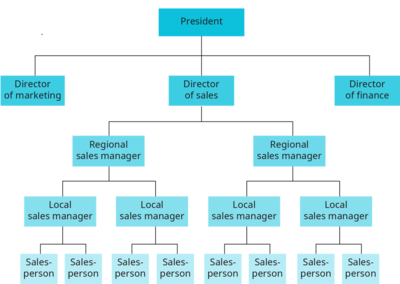Mechanistic Model of Organization
A Mechanistic Model of Organization also known as a bureaucratic structure, describes an organizational structure that is based on a formal, centralized network. The mechanistic structure is best suited for companies that operate in a stable and certain environment. In general, a mechanistic structure is easy to maintain and rarely needs to be changed when an organization operates in a stable environment.
In mechanistic organizations, authority reflects a well-defined hierarchy where top-level managers make the majority of the decisions. Because the environment is relatively stable, complex decision-making processes that involve multiple parties are not required. Subordinates are expected to follow the directions of management and not question their rationale. Communication, much like decisions, also flows through hierarchical routes, or from the top down.
Individualized job specialization is used to place employees into designated tasks. In mechanistic organizations, it is typical for each person to be assigned one task that is relatively stable and easy to control. As a result of the stability of tasks, there tends to be low integration between functional areas or departments in organizations that use a mechanistic structure. Likewise, this creates a situation where, for the most part, functional areas are not dependent on each other.
Think of a mechanistic structure as a well-oiled machine that, once functioning properly, continues to work efficiently with little need for maintenance. Simply envision an organization where management makes most of the decisions, information is communicated based on chain of command, tasks are highly specialized, departments stand alone and operate as their own entity, and change is, for the most part, uncommon. Examples of mechanistic structures include healthcare, universities, and governmental organizations.[1]
The mechanistic organizational structure is the most common business structure and is typically used in a manufacturing environment. This type of organizational structure is bureaucratic, which means it employs a highly centralized authority figure. A set of formal procedures, functions and processes are implemented throughout the organization under a mechanistic organizational structure.
An organizational chart in the mechanistic organizational structure would typically include the Chief Executive Officer, executives, supervisors, managers and support personnel. Individual specialization is prominent among employees at every level within this structure. An organization is typically made of a network of positions based on an employee’s specialization within the company. Usually, each person handles one task within the network of business functions. Within this structure, employees have little daily interaction with members of the structure’s upper executives. Those upper-level employees normally hold tight control over the employees below them, outlining processes and rules that must be adhered to throughout daily business operations.

source: Lawrence J. Gitman et al.
Mechanistic Vs. Bureaucratic Structure
Nearly one-half century ago, Burns and Stalker noted that mechanistic organizations are often appropriate in stable environments and for routine tasks and technologies. In some ways similar to bureaucratic structures, mechanistic organizations have clear, well-defined, centralized, vertical hierarchies of command, authority, and control. Efficiency and predictability are emphasized through specialization, standardization, and formalization. This results in rigidly defined jobs, technologies, and processes. The term mechanistic suggests that organizational structures, processes, and roles are like a machine in which each part of the organization does what it is designed to do, but little else.
It is easy to confuse mechanistic organizations with bureaucracies due to the considerable overlap between these two concepts. Yet despite the overlaps, a primary difference between mechanistic organizations and bureaucracy is the rationale for utilizing each of these. A goal of bureaucratic structures is to protect lower-level administrative positions from arbitrary actions of owners and higher-level managers. For example, an individual holding the job title of vice-president of production would, in a bureaucracy, be protected from indiscriminate changes in work hours, wages, and responsibilities through formal rules, regulations, and grievance procedures. The goal of the bureaucracy is protection of positions within the organization.
Mechanistic organizations, on the other hand, are utilized to increase efficiency when tasks and technologies are relatively stable. The vice-president of production in a mechanistic organization would employ production processes and techniques that minimize waste and maximize outputs for a given quantity of inputs. The goal of mechanistic structures is efficiency. Thus, the rationale for bureaucracy is protection while the rationale for mechanistic organizations is efficiency. Clearly, the two are not mutually exclusive; an organization could be structured as a bureaucracy and also be mechanistic. On the other hand, many examples of inefficient bureaucracies can quickly come to mind, suggesting that while there is overlap between the concepts, there are distinctions as well.
Criticism of Mechanistic Model
At least two criticisms are generally made about mechanistic organizations. First, while focusing on task concerns such as efficiency and standardization, mechanistic organizations tend to ignore human needs and dynamics. Second, creativity, and thus innovation, are restricted by the rigidity of standardized and formalization. Thus, the appropriate environment for mechanistic organizations is a stable environment, while rapidly changing environments require more flexibility. Highly mechanized organizations operating in rapidly changing environments run the risk of becoming obsolete as competitors sacrifice maximum efficiency in exchange for flexibility to tackle new environmental conditions.[2]
See Also
References
- ↑ Definition - What Does Mechanistic Model of Organization Mean? Study.com
- ↑ Criticism of Mechanistic Model Reference for Business
